高中英语状语从句
- 格式:doc
- 大小:8.28 MB
- 文档页数:10
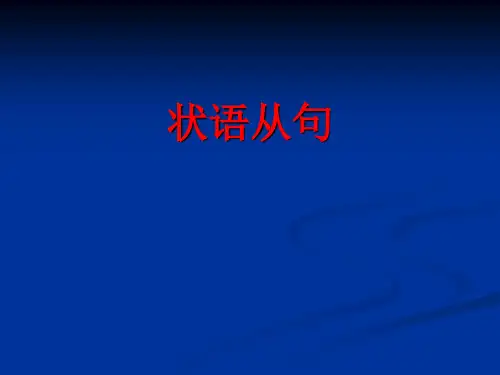

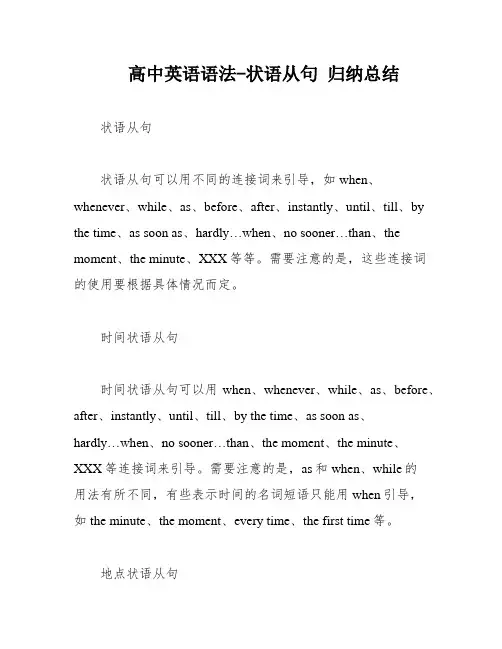
高中英语语法-状语从句归纳总结状语从句状语从句可以用不同的连接词来引导,如when、whenever、while、as、before、after、instantly、until、till、by the time、as soon as、hardly…when、no sooner…than、the moment、the minute、XXX等等。
需要注意的是,这些连接词的使用要根据具体情况而定。
时间状语从句时间状语从句可以用when、whenever、while、as、before、after、instantly、until、till、by the time、as soon as、hardly…when、no sooner…than、the moment、the minute、XXX等连接词来引导。
需要注意的是,as和when、while的用法有所不同,有些表示时间的名词短语只能用when引导,如the minute、the moment、every time、the first time等。
地点状语从句地点状语从句可以用where或XXX来引导。
其中,where 表示某一个地方,而XXX则表示任何一个地方。
原因状语从句原因状语从句可以用because、since、for、as、now that等连接词来引导。
需要注意的是,because语气最强,用来说明人所不知的原因,回答why提出的问题。
而as和since则用来说明显而易见的或已为人们所知的原因。
如果由because引导的从句放在句末并且前面有逗号,则可以用for来代替。
而now that则表示“既然”,需要注意它只能用于现在发生的情况,而since可以用于现在和过去。
条件状语从句条件状语从句可以用if、unless、once、in case、as long as、on n that等连接词来引导。
需要注意的是,多用一般时态,如果表示一般将来的情况,就用一般现在时,如果表示过去将来的情况,就用一般过去时。
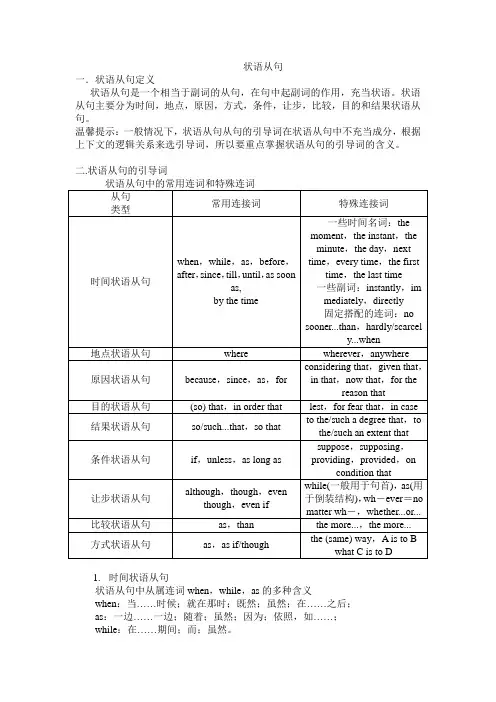
状语从句一.状语从句定义状语从句是一个相当于副词的从句,在句中起副词的作用,充当状语。
状语从句主要分为时间,地点,原因,方式,条件,让步,比较,目的和结果状语从句。
温馨提示:一般情况下,状语从句从句的引导词在状语从句中不充当成分,根据上下文的逻辑关系来选引导词,所以要重点掌握状语从句的引导词的含义。
二.状语从句的引导词一些时间名词:themoment,the instant,theminute,the day,nexttime,every time,the firsttime,the last time一些副词:instantly,immediately,directly固定搭配的连词:nosooner...than,hardly/scarcely...when1.时间状语从句状语从句中从属连词when,while,as的多种含义when:当……时候;就在那时;既然;虽然;在……之后;as:一边……一边;随着;虽然;因为;依照,如……;while:在……期间;而;虽然。
用when,while和as填空:①He will take my place ________ I am away.②I was having my lunch ________ the fire alarm went off.③________ you have finished your work,you may have a rest.④________ he swam,he cried for help.⑤________ the Internet is of great help,I don't think it good to spend too much time on it.【答案】①while②when③When④As⑤Whilebefore的用法注意判断before在状语从句中的含义:才;就;趁……没有;还没来得及;宁可……也不;不知不觉。

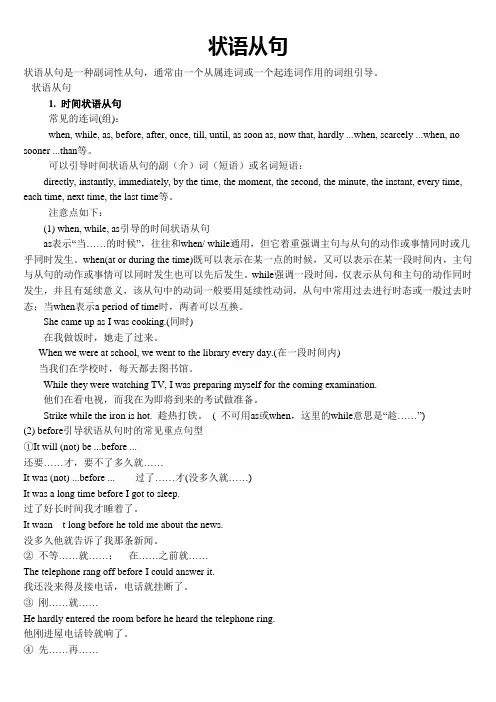
状语从句状语从句是一种副词性从句,通常由一个从属连词或一个起连词作用的词组引导。
状语从句1. 时间状语从句常见的连词(组):when, while, as, before, after, once, till, until, as soon as, now that, hardly ...when, scarcely ...when, no sooner ...than等。
可以引导时间状语从句的副(介)词(短语)或名词短语:directly, instantly, immediately, by the time, the moment, the second, the minute, the instant, every time, each time, next time, the last time等。
注意点如下:(1) when, while, as引导的时间状语从句as表示“当……的时候”,往往和when/ while通用,但它着重强调主句与从句的动作或事情同时或几乎同时发生。
when(at or during the time)既可以表示在某一点的时候,又可以表示在某一段时间内,主句与从句的动作或事情可以同时发生也可以先后发生。
while强调一段时间,仅表示从句和主句的动作同时发生,并且有延续意义,该从句中的动词一般要用延续性动词,从句中常用过去进行时态或一般过去时态;当when表示a period of time时,两者可以互换。
She came up as I was cooking.(同时)在我做饭时,她走了过来。
When we were at school, we went to the library every day.(在一段时间内)当我们在学校时,每天都去图书馆。
While they were watching TV, I was preparing myself for the coming examination.他们在看电视,而我在为即将到来的考试做准备。
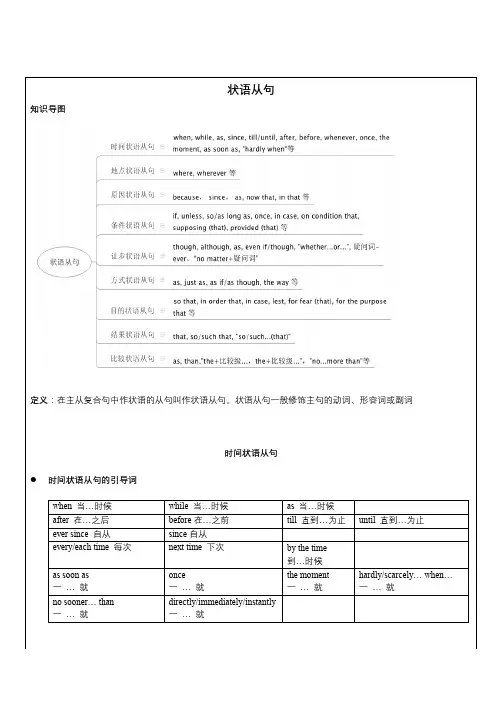
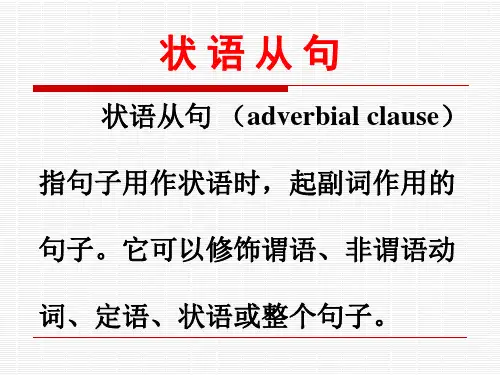
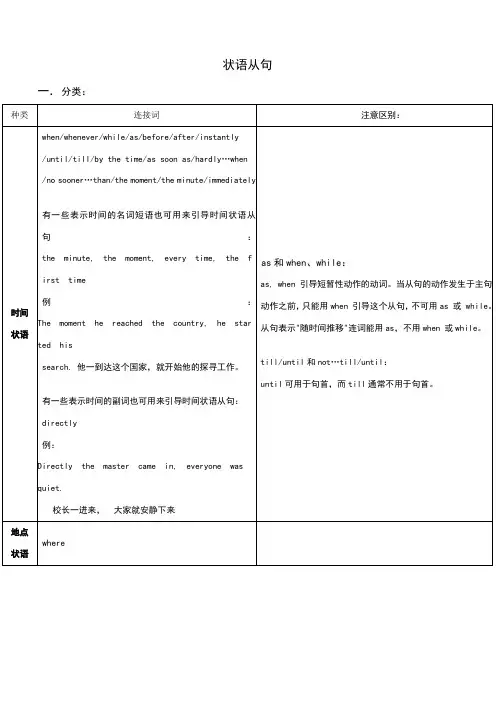
状语从句一.分类:adv.+that(如此……以致) so that(结果……)such+n.+that(如果……以致) that(所以,因此)让步状语从句:though/although不可同but连用。
though/although (虽然) however (可是) even though/if(即使)no matter+what/which/where/who/when=whatever/whichever/wherever/whoever/whenever(不论什么/哪一个/哪里/谁/何时)比较状语从句:as (正如)as…as(和……一样)not as/so … as (不如……) than(比……更)the+比较级…+the+比较级(越……越……)条件状语从句:if(假设) unless(如果不) so long as(只要) on condition that (如果)方式状语从句:as(像……那样地) just as(正像) as if(好像) as though(好像)二.各种状语从句的简化方法:1.以after和before引导的状语从句的主语若与主句主语一致时,从句等于after/before+doing sth.作状语。
例:After she sang,she left the rich man's house. = After singing,she left the rich man's house.2.以as soon as引导的状语从句的主语若与主句主语一致时,从句等于on+doing sth.,作状语,此时的动词为非延续性动词。
例:Mary began to operate on the wounded soldiers as soon as he arrived at the village.= Mary began to operate on the wounded soldiers on arriving at the village.3.时间状语从句和条件状语从句的主语和主句主语一致时,有时可简化为不定式作状语。

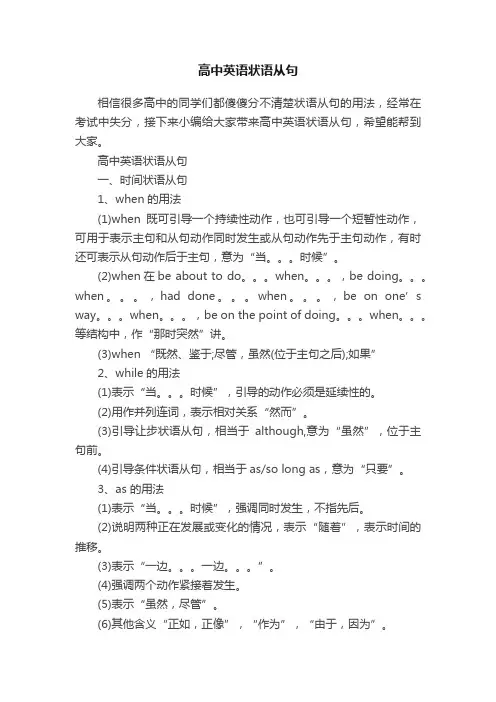
高中英语状语从句相信很多高中的同学们都傻傻分不清楚状语从句的用法,经常在考试中失分,接下来小编给大家带来高中英语状语从句,希望能帮到大家。
高中英语状语从句一、时间状语从句1、when的用法(1)when既可引导一个持续性动作,也可引导一个短暂性动作,可用于表示主句和从句动作同时发生或从句动作先于主句动作,有时还可表示从句动作后于主句,意为“当。
时候”。
(2)when在be about to do。
when。
,be doing。
when。
,had done。
when。
,be on one’s way。
when。
,be on the point of doing。
when。
等结构中,作“那时突然”讲。
(3)when “既然、鉴于;尽管,虽然(位于主句之后);如果”2、while的用法(1)表示“当。
时候”,引导的动作必须是延续性的。
(2)用作并列连词,表示相对关系“然而”。
(3)引导让步状语从句,相当于although,意为“虽然”,位于主句前。
(4)引导条件状语从句,相当于as/so long as,意为“只要”。
3、as 的用法(1)表示“当。
时候”,强调同时发生,不指先后。
(2)说明两种正在发展或变化的情况,表示“随着”,表示时间的推移。
(3)表示“一边。
一边。
”。
(4)强调两个动作紧接着发生。
(5)表示“虽然,尽管”。
(6)其他含义“正如,正像”,“作为”,“由于,因为”。
4、before的用法(1)一般意为“在。
之前”“。
才”,“。
就”“还没有。
”“免得”“不知不觉”“宁可,宁愿”,“否则,要不然”。
(2)It + will be/was + 时间段+before+一般现在时/一般过去时。
在肯定句中,意为“多长时间之后才”;在否定句中,意为“用不了多长时间就”。
5、until和till(1)与肯定句连用,必须是延续性动词。
(2)与否定句连用,必须是非延续性动词,表示“直到。
才,在。
之前不。
高中英语34种状语从句句型讲解_1. 由as引导的非限定性的定语从句。
如:As we have known, he is a most good student.众所周知,他是个很好的学生。
请比较:It is well-known that he is a most good student.(前一个是定语从句,而后者是个主语从句。
)2. 由which引导的非限定性的定语从句。
如:He is a professor, which I have been looking forward to becoming. 他是个教授,那是我一直盼望的职业。
(因为先行词professor是表示职业的名词,因此引导词用which,而不用who。
3. 由where, when引导的定语从句(其中包括限定性的或非限定性的。
)如:This is the house where I used to come.请比较:This is the house which / that I used to come to.This is the day when I joined the Party.请比较:This is the day which / that I joined the Party on.(说明:关于that与which之间的区别,请看关系代词that和which的区别。
)三、让步状语从句4. No matter what / which / who / where / when / whose+从句,+主句.(注意从句中的时态一般情况下用一般现在时态。
)如:No matter what you do, you must do it well.请比较:Whatever you do, you must do it well. 无论你做什么,一定要做好。
No matter where you go, please let me know.请比较:Wherever you go, please let me know.你无论去哪儿,请通知我。
高中英语知识点归纳状语从句的类型和用法状语从句是英语语法中的一个重要知识点,广泛应用于句子中对主句的补充和修饰。
状语从句可以通过引导词或短语来表示不同的含义和用法。
本文将对高中英语中状语从句的类型和用法进行归纳总结。
一、时间状语从句时间状语从句用于表示主句发生的时间或顺序,并通过引导词“when”、“while”、“before”、“after”等来引导。
例如:1. When I was a child, I liked to play football.(当我还是个孩子时,我喜欢踢足球。
)2. She called her mother while she was cooking.(她一边做饭一边打电话给妈妈。
)3. Before you leave, please turn off the lights.(在离开前,请关灯。
)二、地点状语从句地点状语从句用于表示主句所发生的地点,并通常由引导词“where”来引导。
例如:1. I will meet you where we agreed.(我会在我们约定的地方见你。
)2. He found a quiet place where he could read in peace.(他找到了一个安静的地方,可以在那里安心阅读。
)三、原因状语从句原因状语从句用于表示主句的原因或解释,并通过引导词“because”、“since”、“as”来引导。
例如:1. He didn't go to school today because he was sick.(他今天没去上学,因为他生病了。
)2. Since it is raining heavily, we should stay indoors.(因为下大雨,我们应该待在室内。
)四、方式状语从句方式状语从句用于表示主句动作或状态的方式或方法,并通常由引导词“as”、“like”、“the way”来引导。
高中英语状语从句用法详解内容提要:一、时刻状语从句二、地点状语从句三、方式状语从句四、程度状语从句五、缘故状语从句六、结果状语从句七、目的状语从句八、条件状语从句九、让步状语从句十、比较状语从句一、时刻状语从句:1、时刻状语从句通常用下列从属连词来引导:after, before, as, once, till, until, (ever) since, when, whenever, while, now (that), as long as, as soon as。
如:Now (that) you’ve grown up, you must stop this childish behaviour.Whenever we met with difficulties, they came to help us.Come and see us whenever you have time.People do not know the value of health till they lose it.2、有些词,如immediately, directly, instantly 等,当用于as soon as 意义时,也能够引导时刻状语从句,如:I got in touch with him immediately I received his letter.My sister came directly she got my message.The machine will start instantly you press the button.I’ll telephone you directly I hear the news.Will you look for it immediately you get there?3.某些表示时刻的名词词组,如the (very) moment ( = as soon as ), the minute ( = as soon as ), the instant ( = as soon as ), the day, theyear, the morning, every time, each time, next time, the first time 等,也能够引导时刻状语从句,如:I’ll tell you about it the moment you come.I started the instant I heard the report.The instant she saw him she knew he was her brother.Every time I catch a cold, I have pain in my back.I’m going to see him next time he comes to Shenzhen.He left Europe the year World WarⅡbroke out.He had impressed me that way the first time I met him.I started the very moment I got your letter.I’ll tell him the minute (that) he gets here.4.有些关联从属连词,如no sooner …than / hardly …when / sca rcely …when / barely …when 等,也能引导时刻状语从句。
高考英语状语从句的用法归纳一、概说状语从句即指在主从复合句用作状语的从句。
按照其意义,状语从句可分为时间状语从句、地点状语从句、原因状语从句、目的状语从句、结果状语从句、条件状语从句、让步状语从句等。
状语从句是高中英语学习中的一个语法重点,也是历年高考重点考查的内容之一。
学习状语从句主要应注意引导状语从句的从属连词的用法与区别,以及从属连词在一定的语言环境中的意义与用法。
二、时间状语从句1. 引导时间状语从句的从属连词很多,常见的有before, after, when, while, as, since, till, until, as soon as 等。
2. 表示“当…时候”的 while, when, as 的用法区别是:while从句中的谓语动词必须是延续性动词;表示带有规律性的“每当”或当主、从句谓语动词的动作发生有先后时,只能用 when;当表示“一边…一边…”或“随着”时,只能用 as。
另外,用于此义的 as 所引导的时间状语从句谓语只能是动作动词,不能是状态动词。
如下面一道高考题的答案是 B 而不能是A:“I’m going to the post office.” “_____ you’re there, can you get me some stamps?”A. AsB. WhileC. BecauseD. If3. until 在肯定句中通常只连用延续性动词,表示相应动作结束的时间;在否定句中通常连用非延续性动词,表示相应动作开始的时间,意为“直到…才”。
如:He waited until she was about to leave. 他等着一直到她准备离开。
I did not begin to work till he had gone. 他走了后我才开始工作。
4. 表示“一…就”除用 as soon as 外,还可用 the minute, the second, the instant, immediately, directly, instantly, no sooner…than, hardly…when 等。
高中英语九种状语从句口诀:时地缘故条状补,目比结果方让步,连词引导各不同;主句通常前面走,连词引导紧随后,从句若在主前头,主从之间有个逗。
用来修饰谓语动词、其它动词、定语、状语或整个句子的从句叫做状语从句。
状语从句可分为:1.时刻状语从句;(adverbial clause of time)2.地点状语从句;(adverbial clause of place)3.缘故状语从句;(adverbial clause of cause)4.条件状语从句;(adverbial clause of condition)5.目的状语从句;(adverbial clause of purpose)6.让步状语从句;(adverbial clause of concession)7.比较状语从句;(adverbial clause of comparison)8.方式状语从句;(adverbial clause of manner)9.结果状语从句。
(adverbial clause of result)§状语从句的时态特点一样情形下,时刻和条件状语从句的谓语动词一样用“一样现在时”表示“一样今后时”,用“现在完成时”表示“今后完成时”。
例如:1.时刻状语从句;(adverbial clause of time)①由when, while, as引导的时刻状语从句。
例如:When we got home, I find Tom.While my wife was reading the newspaper, I was watching TV.We always sing as we walk.我们总是边走边唱。
②由before和after引导的时刻状语从句。
It will be four days before they come back. 他们要过四天才能回来。
After you think it over, please let me know what you decide.你认真考虑过以后,告诉我你是如何样决定的。
状语从句The Examples of Adverbial Clauses状语从句一、时间状语从句when, while, as, whenever, till, until, after, before, since, once, every/each time, the day一...就...1.As soon as2.The moment/minute/second/instant3.Immediately/instantly/directly4.No sooner...than... hardly/scarcely...when...Than/when 后采用一般过去时,主句采用过去完成时,主倒从不倒。
(adv./prep.位于句首,部分倒装)1.when, while, aswhen用法最广,常可代替while和as, as引导的时间状语从句既可以是延续性动词,又可以是非延续性动词;而while所引导的时间状语从句谓语动词只能是延续性动词,并常与进行时态连用。
1). When I lived in the countryside, I used to carry some water for him.2). While my wife was reading the newspaper, I was watching TV.3). As we were going out, it began to snow.when一般强调特定时间,还可表示:1.就在这时/就在那时突然...2.还没...就...3.一...就...4). When spring came, he felt like a trip.5). We were about to to leave when he came in.6). I had hardly sat down when he stepped in.=Hardly had I sat down when he stepped in.While所引导的时间状语从句强调主句和从句的动作同时发生或相对应,也表示对比。
高中英语定语从句1.掌握必修五M5的语法知识点及其常见考点、命题规律★考点一:时间状语从句Sorry,I was out when you called me.对不起,你给我打电话时我刚好在外面。
考点延伸1)阅读下列句子,体会连词的含义①She gets very bad-tempered when she’s tired.她累的时候就爱发脾气。
连词: 含义:②Please be quiet while I’m tal king to you.我和你说话时,请保持安静。
连词: 含义:③We always sing as we walk.我们总是边走边唱。
连词: 含义:④The stranger waited till my master came home.那个陌生人一直等到我主人回家。
连词: 含义:⑤I’ve earned my own l iving since I was seven.从7 岁起我就自己养活自己。
连词: 含义:2)阅读下列句子,注意连词until (till)的用法①Continue in this direction until you see a sign.一直朝着这个方向走,直到你看见指示牌。
用法:until (till)直到……时(为止)。
till多用于口语,不置于句首;until可以置于句首。
在肯定句中,主句谓语动词为延续动词。
②Don’t open it till your birthday.等到你生日那天再打开。
用法:在否定句中,构成not...until/till结构,表示“直到……才……”,主句谓语动词为终止动词。
③Not until we pointed out their fault to them did they realise it.直到我们向他们指出了他们的错误,他们才意识到。
用法:当not until...置于句首时,主句用部分倒装。
3)阅读下列句子,注意连词since的用法①I haven’t heard from him since he lived here.自从他不在这里住了我就没再收到过他的来信。
用法:since意为“自……以来”。
当since引导的时间状语从句用一般过去时时,主句用现在完成时。
②It is three years since he began to smoke.他吸烟已有3年了。
用法:常用句型:It is/has been+一段时间+since...,表示“自从……起到现在已有一段时间了”,since从句中用一般过去时。
4)immediately,instantly,the instant,the moment/minute等引导时间状语从句,相当于as soon as,表示“一……就”,表示从句的动作一发生,主句的动作随即发生。
Return immediately you are done.事情一做完就回来。
5)含time的短语可引导时间状语从句。
time 短语有every time(每当……的时候),each time(每当……的时候),(the) next time(下次……的时候),(the) last time(上次……的时候),by the time(到……的时候),the first time(第一次……的时候),any time (任何……的时候)等。
①Every time I listen to music,I’ll think of it.每当我听音乐时,我就会想起它。
②He didn’t tell me anything the last time I saw him.上次我见到他时他什么也没告诉我。
★考点二:原因状语从句引导原因状语从句的从属连词有because(因为),as(由于),since(既然),now that(既然)等。
I do it because I like it.我做这件事是因为我喜欢。
考点延伸1)阅读下列句子,注意连词的用法①She can drive by herself because she has passed her test.她现在可以独立开车了,因为她已经通过了驾驶考试。
用法:because 语气最强,一般指事情发生的直接原因,用来回答why的提问。
②As it was raining,I stayed at home.由于下雨,我便待在家里。
用法:as语气较弱,意为“由于,鉴于”,指客观事实。
③Since you’re not interested,I won’t tell you about it.既然你不感兴趣,那我就不告诉你了。
用法:since指双方都明确的原因或众所周知的原因,译为“既然”。
④Now that you are well again,you can travel.既然你恢复了健康,你就可以去旅行了。
用法:now that 表示原因,常用来说明一种新情况,然后加以推论,常译为“既然”。
2)强调句中只能强调because引导的原因状语从句,不能强调as,since,now that等引导的原因状语从句。
It was because he lacked an education that he had done so poorly.他之所以做得糟糕,是因为过去没有受过教育。
3)because引导的从句还可以做表语,用于句型:That’s because...那是因为……That’s because the Internet attracts more and more users.那是因为互联网吸引着越来越多的用户。
★考点三:条件状语从句引导条件状语从句的连词主要有if,unless,as/so long as,on condition that 等。
If you have finished eating,you may leave the table.你要是吃完了,就可以离席了。
考点延伸1)阅读下列句子,体会连词的含义①If you make a promise,you should fulfill it.如果你许诺了,就要履行你的诺言。
连词: 含义:②Unless he studies hard,he will never pass the examination.他如果不努力学习,就永远考不及格。
连词: 含义:③I’ll never forget that as long as I am living.那件事我至死也不会忘记。
连词: 含义:④He can use the bicycle on condition (that) he returns it tomorrow.自行车可以借给他,条件是明天必须归还。
连词: 含义:2)阅读下列句子,体会if条件状语从句中的时态及含义①The party will be postponed if it rains tomorrow.如果明天下雨,聚会将会延期。
用法:if条件状语从句中用一般现在时表示将来。
②If he were here I could explain to him myself.要是他在这里,我就可以亲自向他解释了。
用法:if从句如果表达非真实的条件,用虚拟语气;与现在情况相反时,从句谓语用一般过去时,be动词常用were。
★考点四:让步状语从句引导让步状语从句的连词主要有although,though,as,even though,even if,however,whatever,whoever,wherever,whenever,no matter+how/what/who/where/which 等。
①I will try it,though I may fail.即使可能失败,我也要试一下。
②We’ll go even if it rains.即使下雨我们也要去。
考点延伸1)阅读下列句子,体会连词的含义①Although he is poor,he’s still happy.虽然他很穷,他仍然很快乐。
连词: 含义:②It’s quite pleasant today,though the wind is rather cool.尽管风有点凉,今天天气还是很不错的。
连词: 用法:一般可与although互换,但其引导的让步状语从句也可和as引导的让步状语从句一样用倒装语序。
③Much as I respect him,I can’t agree to his proposal.尽管我很尊敬他,我却不同意他的建议。
连词: 用法:引导的让步状语从句中必须将表语、副词、动词原形等提到as之前。
④He’s the best teacher,even though/if he has the least experience.他虽然经验最少,却是最出色的老师。
连词: 含义:⑤She promised to phone.I heard nothing,though.她答应要打电话来,可我没接到。
用法:though可用作副词,一般放在句末(不放在句首)含义:2)阅读下列句子,体会连词的用法和含义①However great the difficulties may be,we can overcome them.再大的困难我们都能克服。
用法:however引导让步状语从句,意为“不管多么的……”,可替换成no matter how。
②Later,however,he made up his mind to go.可是,后来他决定去了。
用法:however为副词,意为“可是,然而”。
③He always has an eye to making money whatever his plans are.不管他的计划如何,他的目的就是赚钱。
用法:whatever引导让步状语从句,意为“不管什么”,可替换成no matter what。
④Whatever is worth doing at all is worth doing well.任何一件值得做的事都值得做好。
用法:whatever引导名词性从句,意为“任何……的事”,可替换成anything that。
⑤You can ask for help whenever you need it.你如果需要帮助随时可以提出来。
用法:whenever引导让步状语从句,意为“无论何时,随时”,可替换成。
⑥May I come and talk with you whenever it’s convenien t?在你方便时我能来和你谈谈吗?用法:whenever引导时间状语从句,意为“当……时候”,语气比when重。